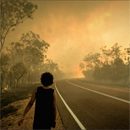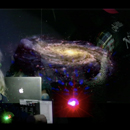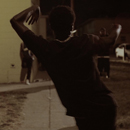Wesleyan University's Ezra and Cecile Zilkha Gallery presents "A SCULPTURE, A FILM AND SIX VIDEOS" through November 22, 2020

Renée Green: "Americas: Veritas"
"Americas: Veritas" by Renée Green '81 is the first video being screened as part of the exhibition "A SCULPTURE, A FILM & SIX VIDEOS" in the Ezra and Cecile Zilkha Gallery from Tuesday, September 8 through Saturday, September 19, 2020. Gallery open to Wesleyan students, faculty, and staff. Image courtesy of Renée Green, FAM, and Bortolami Gallery.
Click here to download high resolution version.
"Americas: Veritas" by Renée Green '81 is the first video being screened as part of the exhibition "A SCULPTURE, A FILM & SIX VIDEOS" in the Ezra and Cecile Zilkha Gallery from Tuesday, September 8 through Saturday, September 19, 2020. Gallery open to Wesleyan students, faculty, and staff. Image courtesy of Renée Green, FAM, and Bortolami Gallery.
Click here to download high resolution version.

Karrabing Film Collective: "The Mermaids or Aiden in Wonderland"
“The Mermaids or Aiden in Wonderland" by the Karrabing Film Collective is the second video being screened as part of the exhibition "A SCULPTURE, A FILM & SIX VIDEOS" in the Ezra and Cecile Zilkha Gallery from Sunday, September 20 through Friday, October 2, 2020. Gallery open to Wesleyan students, faculty, and staff. Image courtesy of Karrabing Film Collective.
Click here to download high resolution version.
“The Mermaids or Aiden in Wonderland" by the Karrabing Film Collective is the second video being screened as part of the exhibition "A SCULPTURE, A FILM & SIX VIDEOS" in the Ezra and Cecile Zilkha Gallery from Sunday, September 20 through Friday, October 2, 2020. Gallery open to Wesleyan students, faculty, and staff. Image courtesy of Karrabing Film Collective.
Click here to download high resolution version.

Trisha Baga: “Winters Spring”
“Winters Spring” by Trisha Baga is the third video being screened as part of the exhibition "A SCULPTURE, A FILM & SIX VIDEOS" in the Ezra and Cecile Zilkha Gallery from Saturday, October 3 through Thursday, October 15, 2020. Gallery open to Wesleyan students, faculty, and staff.
Click here to download high resolution version.
“Winters Spring” by Trisha Baga is the third video being screened as part of the exhibition "A SCULPTURE, A FILM & SIX VIDEOS" in the Ezra and Cecile Zilkha Gallery from Saturday, October 3 through Thursday, October 15, 2020. Gallery open to Wesleyan students, faculty, and staff.
Click here to download high resolution version.

Stanya Kahn: "Stand in the Stream"
"Stand in the Stream" by Stanya Kahn is the fourth video being screened as part of the exhibition "A SCULPTURE, A FILM & SIX VIDEOS" in the Ezra and Cecile Zilkha Gallery from Friday, October 16 through Wednesday, October 28, 2020. Gallery open to Wesleyan students, faculty, and staff. Image courtesy of Stanya Kahn and Vielmetter Los Angeles, ©Stanya Kahn.
Click here to download high resolution version.
"Stand in the Stream" by Stanya Kahn is the fourth video being screened as part of the exhibition "A SCULPTURE, A FILM & SIX VIDEOS" in the Ezra and Cecile Zilkha Gallery from Friday, October 16 through Wednesday, October 28, 2020. Gallery open to Wesleyan students, faculty, and staff. Image courtesy of Stanya Kahn and Vielmetter Los Angeles, ©Stanya Kahn.
Click here to download high resolution version.

Arthur Jafa: "APEX"
"APEX" by Arthur Jafa is the fifth video being screened as part of the exhibition "A SCULPTURE, A FILM & SIX VIDEOS" in the Ezra and Cecile Zilkha Gallery from Thursday, October 29 through Sunday, November 8, 2020. Gallery open to Wesleyan students, faculty, and staff. Image courtesy Arthur Jafa, Gladstone Gallery, New York and Brussels.
Click here to download high resolution version.
"APEX" by Arthur Jafa is the fifth video being screened as part of the exhibition "A SCULPTURE, A FILM & SIX VIDEOS" in the Ezra and Cecile Zilkha Gallery from Thursday, October 29 through Sunday, November 8, 2020. Gallery open to Wesleyan students, faculty, and staff. Image courtesy Arthur Jafa, Gladstone Gallery, New York and Brussels.
Click here to download high resolution version.
"A SCULPTURE, A FILM, & SIX VIDEOS" is an exhibition amidst the greater context of a global pandemic, racial reckoning, economic crisis, and climate emergency. As our experiences of our present time are increasingly measured by their proximities to ending(s) this exhibition looks towards experiences of continuation in time. While we reimagine a way forward, to what degree can we look to the form of time itself to hold the power for transformation?
"This show, which has been in the works for some time, feels even more relevant today as our experience of ourselves, our relationships, and the world around us is increasingly mediated by projections and through screens," said curator Benjamin Chaffee. "In the era of a global pandemic and the global response to racial uprisings in the U.S., these artists present possibilities for how to organize time--from broadening the scope of the present to collapsing it with the past. This includes encountering death, and the beliefs we engage to build an image of the future."
The exhibition has been on view in Wesleyan University’s Ezra and Cecile Zilkha Gallery since Tuesday, September 8, 2020. Due to the COVID-19 pandemic, the gallery is currently open to Wesleyan students, faculty, and staff.
Please see below for more information about the exhibition and related events, both online and in the gallery.
About the Exhibition
Nestled into a custom-built atrium in the gallery, Peter Fischli and David Weiss’ sculpture “Son et Lumiere (Le Rayon Vert)” (1990) acts as the pivot or fulcrum for the entire exhibition, the rotating kinetic sculpture around which everything else revolves.
Acting as a counterweight, a proto-cinematic object, and a foil, the sculpture was installed for the entire run of the exhibition, and the six videos rotate out, with one work projected continuously for two weeks at a time. The vaulted space of the main gallery is darkened into a projection space. As the videos are not be seen in the same place at the same time, they exist in relation to each other only through memory, engaging one of the fundamental properties of the moving image in the structure of the exhibition itself.
The video works address temporal continuities and discontinuities in time. They connect a deep mystical time to the present tense, visualize cycles, and reach into the future for the potential it may hold for transformation. Referenced in the subtitle of the sculpture, the green ray is a naturally-occurring phenomenon, a flash of green light crossing the sky after the sun has set.
In the 19th century, it was a widely-held Romantic belief in Europe that observing the green ray gave the viewer a heightened perception of the world, and viewing the ray was indicative of a coming transformation. In "Pirates of the Caribbean: At World’s End" (2007), the green flash is seen as a sign that a soul has returned to the living. Jules Verne encapsulated that ideal in his 1882 novel "The Green Ray," referring to the color as “the true green of Hope”.
In her collected writings, Tacita Dean explains that “looking for the green ray became about the act of looking itself, about faith and belief in what you see.” Dean’s 16mm film "The Green Ray" (2001) is being screened in the gallery as an event rather than a film installation as it has typically been exhibited. The green ray grounds the temporal framework of the exhibition itself and the specificity of media’s relation to time, delineating difference of time in sculpture, in video, in film, in performance, in event, in exhibition.
Related Online Events
FREE!
Artist Talk: Stanya Kahn
Wednesday, October 21, 2020 at 8pm
Zoom Webinar
RSVP required for access to virtual event
Artist Stanya Kahn will speak about “Stand in the Stream,” her work included in the exhibition “A SCULPTURE, A FILM & SIX VIDEOS” which is streaming online through Wednesday, October 28, 2020, sharing more about the video’s blend of intimate family events and deeply felt political engagement. Kahn will discuss some of the themes in “Stand in the Stream,” the process of making the ambient, hour-long digital feature film shot on multiple camera formats over a period of six years, and about its connection with other aspects of her work in other media including painting, drawing, and ceramics. The film’s vast and varied footage—all shot live or screen-captured during livestreams by Kahn in real time—is edited to create a visceral reflection of life, power, and uprising in late capitalism. Kahn will also discuss the connections to her latest moving-image work, the new 16mm film “No Go Backs.” Both works are included in a current solo presentation of Kahn’s work at the Institute of Contemporary Art, Los Angeles.
Stanya Kahn is an interdisciplinary artist working primarily in video with a practice that includes drawing, sound, writing, performance, and sculpture/installation. Humor, pathos, and the uncanny are central to a hybrid media practice that seeks to re-work relationships between fiction and document, the real and the hyper-real, and narrative time and the synchronic time of impulse. In a long-term investigation of how rhetoric gains and loses power, Kahn’s projects often situate language in the foreground of works that are dialectically driven by the demands of the body.
Performance by Tosh Basco (aka boychild): "Untitled: darkness"
Followed by a conversation with the artist and collaborator Wu Tsang
Saturday, November 7, 2020 at 2pm
Zoom Webinar
RSVP required for access to virtual event.
The new work "Untitled: darkness" (2020) by Zürich-based performance artist Tosh Basco (aka boychild) is made in conversation with the filmic technologies of the camera, screens, and sight. The online performance will be followed by a live conversation between the artist and collaborator Wu Tsang. This performance is part of the Institute for Curatorial Practice in Performance's Performing Artist Case Studies, funded by the Doris Duke Charitable Foundation.
"Untitled: darkness" is a performance in the liminal and interstitial. Part of Basco's "Untitled" series, the performance works with/in and through that which is unseeable, to insist on modes of being that exist outside of generalized conceptions of visibility. How can devotional practices teach us to see through? How might one dance the space between? Through improvisational movement, Basco explores the kinetic dimension of the unseen, traversing and opening up a terrain between language, seeing, and touching.
Tosh Basco is a movement-based performance artist whose work operates through improvisation as a mode of survival and world building in the liminal, performative space where becoming meets representation. Adamant about the visceral experience of live visual performance, she makes a case for how the movement of form can communicate what remains impenetrable in images, and through language. Her performances have been presented at the Gropius Bau, the Venice Biennale, the Sydney Biennial, the Whitney Museum of American Art, MoMA PS1, the San Francisco Museum of Modern Art, the Museum of Contemporary Art Chicago, MOCA Los Angeles, the Stedelijk Museum Amsterdam, ICA London, and Berghain. Tosh Basco has toured with Mykki Blanco, and collaborated with Korakrit Arunanondchai and Wu Tsang, as well as the streetwear label Hood By Air.
Conversation: Collective for Radical Death Studies and devynn emory with Anthony Ryan Hatch
Monday, November 9, 2020 at 7:30pm
Zoom Webinar
RSVP required for access to virtual event.
A conversation between the Collective for Radical Death Studies—an international, professional organization formed to decolonize, challenge, and de-center the presence of whiteness in the field of death studies and radicalize death practice—and choreographer, dance artist, acute care and COVID-19 hospice nurse devynn emory. Moderated by Anthony Ryan Hatch, Chair and Associate Professor of Science in Society, African American Studies, Sociology, Environmental Studies, and the College of the Environment, and Coordinator for Sustainability and Environmental Justice at Wesleyan University. This event is in dialogue with Arthur Jafa’s “APEX,” which will be screened in the Ezra and Cecile Zilkha Gallery from Thursday, October 29 through Tuesday, November 8, 2020.
The Collective for Radical Death Studies is a group of scholars, funeral directors, death work practitioners, activists and students who interrogate and intervene in death studies in theory and practice. The collective seeks to radicalize engrained perceptions of death by way of research, writing, and community work. Engaged in analyzing death, mourning, and burial, both in the past and present, the collective’s work includes the creation of a Radical Death Canon to be used as a tool to decolonize our understanding of death, dying, and associated rituals of care. Additionally, the collective works actively towards increasing diversity in death scholarship and conversations, and also serves as a resource for marginalized individuals and communities in relation to death and end-of-life rituals.
devynn emory's performance work draws from their multiple in-between states of being, both as a mixed-race indigenous and transgender person and in holding space for liminal bodies bridging multiple planes of transition. This liminal space of transit also has resonance in emory’s experience as a healer, bodyworker, and ceremonial guide where they spent hours assisting others moving towards or away from death. Institutionally trained, emory’s practice is committed to formalism as a tool for structural reclamation, challenging how a predominantly white aesthetic lens has created patterns and a legitimization of subjugation within their own body. In creating spaces for queer and othered bodies, emory’s investment in radical pattern making functions as a “survival skill,” creating spaces of collective support for queer and othered bodies to locate the self, and interrogate historic and contemporary systems.
Dr. Anthony Ryan Hatch is a sociologist and an expert in health systems, medical technology, and social inequalities. From Atlanta, Georgia, Dr. Hatch began his career in community-based public health research and education at Emory University, working on projects related to drug use, HIV/AIDS, and mental health. He received his A.B. in Philosophy from Dartmouth College and both his M.A. and Ph.D. in sociology from the University of Maryland at College Park.
Artist Talk: Karrabing Film Collective
Wednesday, November 11, 2020 at 6pm
Zoom Webinar
RSVP required for access to virtual event
Members of the Karrabing Film Collective will discuss their practice with one of the founding members, author Elizabeth A. Povinelli. The Karrabing Film Collective uses film to analyze contemporary settler colonialism and through these depictions challenge its grip. In the shadow of Third Cinema and Theatre of the Oppressed, Karrabing is creating a new model for Indigenous filmmaking and activism. Co-sponsored at Wesleyan by the History Department and Center for the Humanities in conjunction with their fall 2020 theme of “Dirt.”
Talk and Reading: Victoria Pitts-Taylor
Tuesday, November 17, 2020 at 6pm
Zoom Webinar
RSVP required for access to virtual event.
Professor and Chair of Wesleyan's Feminist, Gender, and Sexuality Studies Program, and Professor of Sociology and Science in Society Victoria Pitts-Taylor presents a book reading and a discussion of Charlotte Prodger’s video "BRIDGIT" (2016), which will be available to stream on the exhibition website and screened in the Ezra and Cecile Zilkha Gallery from Tuesday, November 10 through Sunday, November 22, 2020.
Artist Talk: Renée Green '81
Thursday, November 19, 2020 at 6pm
Zoom Webinar
RSVP required for access to virtual event.
Artist Renée Green '81 will speak about her practice. Her 33 minute video "ED/HF" is streaming online through Sunday, November 22, 2020. Her seven minute digital film "Americas: Veritas" (2018) was screened in the Ezra and Cecile Zilkha Gallery from Tuesday, September 8 through Saturday, September 19, 2020. Talk co-sponsored by Wesleyan's Department of Art and Art History.
Streaming Video: Stanya Kahn - "Stand in the Stream"
Now through Wednesday, October 28, 2020
"Stand in the Stream" (2011–17) is an ambient, hour-long digital feature film shot on multiple camera formats over the course of six years. The film’s vast and varied footage—all shot live or screen-captured during livestreams by Kahn in real time—is edited to create a visceral reflection of life, power, and uprising in late capitalism. As the film travels through cities and wilderness, domestic and public spaces, online chat-rooms, and home movies, it is framed by the decline and death of the artist’s mother—a shipyard electrician and activist—with glimpses of Kahn’s own experience of motherhood and the toil of daily life. "Stand in the Stream" situates these intimacies within the shift of political and digital landscapes over time, revealing many intersections of the personal and the political. With a soundscore constructed to draw the epic from the mundane, "Stand in the Stream" plays back capitalism’s acculturation of our very personhood while bringing forth insistent images of our resistance and resilience against it. Video streaming courtesy of the artist and Vielmetter Los Angeles, copyright Stanya Kahn.
Streaming Video: Renée Green - "ED/HF"
Now through Sunday, November 22, 2020
Renee Green '81 breaks down timelines of all magnitudes: modernist progress narratives, art historical canons, and lifespans. In her 33 minute video "ED/HF" (2017), Green foregrounds the life and memory of her friend and collaborator Harun Farocki. With the tenor of a contemporary installation, "ED/HF" functions as a memorial, of sorts, both lifting Farocki’s life out of distant memory into the present, and creating a dialogue between two friends. Green, who calls the piece “a film as a conversation,” says that she “wanted it to be blurry.” The video oscillates between different voices and conceptual anchors: America and Germania, institutions and individuals, and distance and intimacy. Green’s scholarly enterprises are united with creative expression as both artists examine the impact of migration and displacement on their respective practices. The blurring in Green’s video best articulates the lack of precision that emerges when trying to piece together someone’s life. Reviewing materials and memories to build a portrait of a lost collaborator is always evolving and always incomplete. Video streaming courtesy of the artist, FAM, and Bortolami Gallery.
Streaming Video: Karrabing Film Collective - "Wutharr, Saltwater Dreams"
Now through Sunday, November 22, 2020
In the Emmiyengal language, karrabing means “low tide,” and refers to a collectivity outside structures of government, clanship, or land ownership. The term also invokes the work of the Karrabing Film Collective, as through film and installation the group addresses and intervenes in legacies of colonial violence which are often shrouded by traditional narratives of history but nonetheless resonate with long standing effects. In the 28 minute video "Wutharr, Saltwater Dreams" (2016), three varied accounts from members of a family are offered to explain the cause of a boat breakdown, engaging with intersecting forces including angered ancestral spirits, state authorities and the bureaucracy of settlement, and Christian faith. Shot on an iPhone, the film offers a tangled and nuanced vision of a forever entwined past and present. The work of the Karrabing Film Collective dramatizes and satirizes the political, social, and economic conditions faced by members of the collective. Characteristically fluid in form, the films produced by the group often follow nonlinear structures and allude to the amorphous and transient quality of history and memory. As founding member Elizabeth A. Povinelli reflects in a feature about the Karrabing Film Collective in Art Review, the narratives of the collective’s films engage with a complex understanding of the past and present, fact and fiction, as “it’s a story, but it’s real…not exactly what happens but what happens.” Video streaming courtesy of the artists. Additional support and co-sponsorship for Karrabing Film Collective is provided by Wesleyan University's Anthropology Department, History Department, and Center for the Humanities in conjunction with their fall 2020 theme of "Dirt."
Streaming Video: Charlotte Prodger - "BRIDGIT"
Tuesday, November 10 through Sunday, November 22, 2020
Shot entirely on Charlotte Prodger’s iPhone, “BRIDGIT” (2016) is a 32 minute video constructed of shots up to four minutes in length, the maximum determined by the data storage system on the phone. Video and photography are usually captured through a camera viewfinder which positions the artist’s eye behind the camera’s body. This positionality allows the audience to plausibly imagine seeing what the artist saw when they were capturing the image. iPhones allow us to place the phone at arm’s length while using the camera. This slight displacement introduces a third position in the construction of an image, distinct from both artist and viewer. “BRIDGIT” feels at once more intimate to Prodger’s body and also more separate from her gaze.
Frances Whorall-Campbell writes in “The Queer Subjectivity of Charlotte Prodger’s ‘BRIDGIT’” that “‘BRIDGIT’ dwells in particular on this concept of prosthesis, proposing various contemporary, historical, and bodily technologies as ways through which the ‘I’ not only expands but also mutates, absorbing the fragments of others without ceasing to be itself.” Prodger brings consideration of prosthesis into the narrative of the video by referencing and reading from Allucquére Roseanne Stone, a pioneering theorist in the academic field of transgender studies. Stone’s important essay “The Empire Strikes Back: A Postransexual Manifesto” grounds the act of “passing” in post-structuralist theory as “reading oneself aloud.”
The power of reading and of being read find their grounding in parallel to the act of naming and the power of names. “Sandy” Stone is herself a homonym to “standing stones”. The Neolithic stones appearing in “BRIDGIT” stand still while our names for them and our attention to them fluctuates. Prodger unearths a metaphor for gender fluidity and the social construction of gender in our understanding of the stones. The proximity of these ideas is enough to queer the literal and metaphoric ground of the video. Returning to the title of the piece, Prodger reads from a passage in Julian Cope’s “The Modern Antiquarian” about naming in the ancient world. “Bridgit couldn’t possibly have been her name, because her Neolithic contemporaries all had one-syllable names.” Cope explains that ancient deities had many names. “Not only were they known by different names in different places, but they often had at least three different phases: old, middle-aged, and young, which were all known by different names in one place.”
Prodger explains “The weight of different names by which Bridgit was formerly-known is because of the vast timescales across which she operated…The idea behind taking a name appropriate to one’s current circumstance was that identity isn’t static.” This paradox of self perception and expression “holds the tension between the self’s essential continuity and inevitable mutation.” The landscapes depicted in “BRIDGIT” are given the same care and consideration by the artist allowing each place to be distinct, irreducible, and to retain some of its mystery. Prodger foregrounds her own subjective approach to place through the use of voiceover which imbues the landscapes in the video with their individuality and specificity.
The audio in “BRIDGIT” combines scene sound from Prodger’s iPhone with her voiceover which was recorded separately. The close recording of the narration abstracts her voice from the audible resonances of a physical setting into a psychological space. This intimacy is doubled in one of the alternate narratives in the video. Prodger shares the story of her own visits with anesthesiologists, preparing for and recovering from anesthesia. The conversations she had with the medical staff and their care and thoughtfulness with her become structured moments of passage and transition in and out of self-consciousness. The recovery nurse made a 3D animation which is included in the video. “His job is to be there when people regain consciousness…managing and assisting their various altered states.” “BRIDGIT” leads us through an awareness of the concepts mentioned above. Rather than discrete experiences, the theories of reading, transitioning, passing, names, and naming, are deepened beyond a singular story or anecdote. They open pluralities for us as viewers creating space for us to become resensitized to our everyday as carefully considered empathic and somatic experiences.
Video streaming courtesy of the artist and Hollybush Gardens, London.
Related Events in the Ezra and Cecile Zilkha Gallery
FREE! Gallery open to Wesleyan students, faculty, and staff.
Video Screening: Renée Green '81 - "Americas: Veritas"
Tuesday, September 8 through Saturday, September 19, 2020
Video Screening: Karrabing Film Collective - "The Mermaids or Aiden in Wonderland"
Sunday, September 20 through Friday, October 2, 2020
Film Screenings: Tacita Dean — "The Green Ray"
Wednesday, September 30, 2020 at 12:10pm
Wednesday, October 28, 2020 at 12:10pm
Friday, November 13, 2020 at 12:10pm
Video Screening: Trisha Baga - "Winters Spring"
Saturday, October 3 through Thursday, October 15, 2020
Video Screening: Stanya Kahn — "Stand in the Stream"
Friday, October 16 through Wednesday, October 28, 2020
Video Screening: Arthur Jafa - "APEX"
Thursday, October 29 through Tuesday, November 8, 2020
Video Screening: Charlotte Prodger - "BRIDGIT"
Tuesday, November 10 through Sunday, November 22, 2020